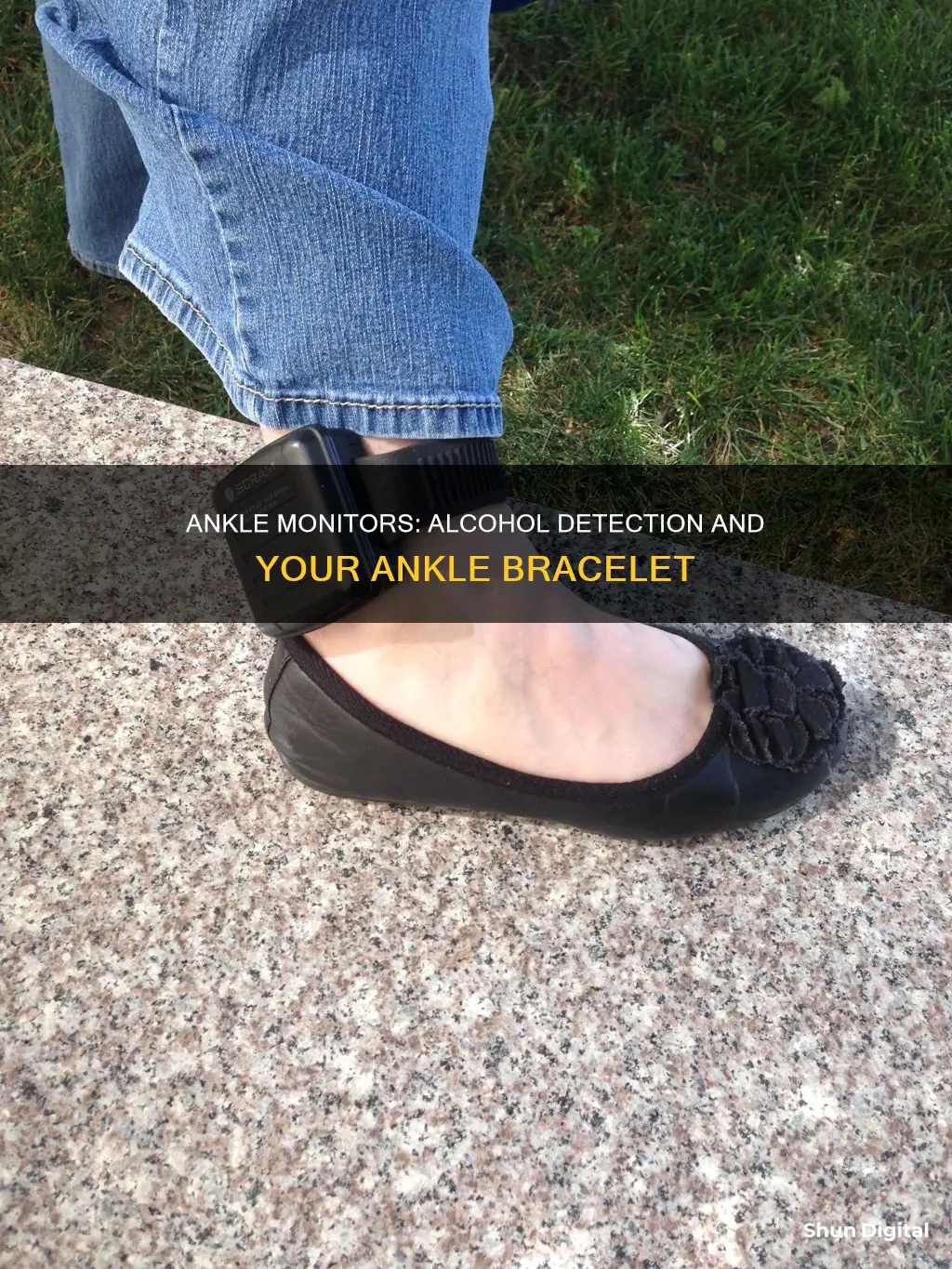
SCRAM (Secure Continuous Remote Alcohol Monitor) ankle bracelets are commonly used to monitor the blood alcohol concentration of DUI offenders. The bracelet works by sampling the wearer's perspiration every 30 minutes to detect the presence of alcohol. This is known as transdermal alcohol testing and is an effective way to monitor alcohol consumption without the need for breathalyzer tests. The data collected by the bracelet is then transmitted to a central database, where it is analysed and reported to the relevant authorities. While SCRAM bracelets are typically ordered by courts for DUI cases, they can also be used in other situations where alcohol use is a concern, such as family court, domestic violence cases, and underage drinking.
| Characteristics | Values |
|---|---|
| Name | SCRAM (Secure Continuous Remote Alcohol Monitor) |
| Weight | Lightweight (approx. 8 oz) |
| Testing | Measures perspiration every 30 minutes |
| Technology | Electrochemical fuel cell |
| Installation | Intuitive installation, hypoallergenic soft rubber strap |
| Alert System | Sends alerts to a database, which is then reviewed by analysts |
| Data Transmission | Transmits data wirelessly to the SCRAM Wireless Base Station |
| Anti-Tamper | Equipped with industry-leading anti-tamper technology, including temperature and infrared sensors |
| Waterproof | Not waterproof, triggers an alarm if submerged in water |
| Use Cases | DUI offenders, domestic violence offenders, family court, underage drinking, drug court offenders |
| Average Duration | 90 days |
What You'll Learn

SCRAM CAM® bracelet features
The SCRAM CAM® bracelet is an innovative way to monitor alcohol consumption. It is a lightweight ankle bracelet that uses transdermal technology to test the wearer's perspiration for alcohol every 30 minutes. This allows the bracelet to create a detailed profile of the wearer's alcohol consumption patterns, which can be used in legal settings. The bracelet is equipped with an electrochemical fuel cell that reacts with ethanol in the wearer's perspiration to measure blood alcohol content. This is the same technology found in portable breath-testing devices. The bracelet is also fitted with temperature and infrared sensors that can detect any attempts to tamper with or obstruct the device.
The SCRAM CAM® bracelet is designed to be easy to install and can be fitted to any ankle. It has a hypo-allergenic soft rubber strap and a robust tamper clip to ensure that it is secure. The bracelet is also equipped with industry-leading anti-tamper technology that identifies any attempts to remove or circumvent the device. If the wearer attempts to remove the bracelet, submerge it in water, or obstruct the skin sensor, the monitoring company and the court or probation department will be immediately alerted.
The SCRAM CAM® bracelet is designed to have minimal disruption on the wearer's daily life. It is small and lightweight, allowing the wearer to go about their daily activities such as working, exercising, and running errands. The bracelet is also waterproof, so the wearer can shower and bathe without issue. However, swimming is not allowed as it may be interpreted as an attempt to destroy the device. The bracelet also has a long battery life and can store data for up to 48 hours in the event of a power outage.
The data collected by the SCRAM CAM® bracelet is transmitted wirelessly to the SCRAM Wireless Base Station, where it is stored and uploaded to the SCRAM Optix™ online monitoring software. This data is then analysed by trained analysts who review any alerts and surface any violations to the supervising authority. The SCRAM CAM® bracelet is also equipped with GPS capabilities, allowing courts and probation departments to monitor the wearer's location and ensure they are complying with any house arrest or curfew orders.
Elgato HD60: Monitor Connection Conundrum?
You may want to see also

How SCRAM CAM® works
The SCRAM CAM® bracelet is an alcohol detector in the form of an ankle bracelet. It is designed to monitor blood alcohol concentration and is often court-ordered for DUI offenders. SCRAM stands for "Secure Continuous Remote Alcohol Monitor". These devices are also known as Continuous Alcohol Monitoring (CAM) bracelets.
The SCRAM CAM bracelet tests the wearer's perspiration automatically every 30 minutes, 24 hours a day, to detect the presence of alcohol. This skin-level measurement is known as "transdermal" alcohol concentration. The bracelet vibrates slightly whenever it takes a reading, and most users report getting used to the vibrations within the first day. It measures what is known as insensible perspiration, which is always present on our skin. The bracelet tests for alcohol that comes through the skin around the wearer's ankle.
The SCRAM CAM bracelet is different from breath, blood, or urine testing because it samples perspiration automatically to measure alcohol consumption. It is completely non-invasive and unobtrusive during daily activities or sleep. The bracelet also tests for any attempts to tamper with the device, obstruct testing, or remove it. Wearers are required to sign an agreement prohibiting the use of products containing alcohol on or around the bracelet.
The SCRAM CAM bracelet automatically transmits testing data to the SCRAM Wireless Base Station, where it is stored and uploaded to the SCRAM Optix™ online monitoring software. Alerts generated by the bracelet are reviewed by a team of professionally trained analysts, who then notify the supervising authority of any violations. This continuous, automated monitoring eliminates the opportunity for drinkers to schedule their drinking around test schedules.
The SCRAM CAM bracelet is equipped with industry-leading anti-tamper technology that identifies circumvention attempts. It has an intuitive installation, with a hypoallergenic soft rubber strap that can be easily fitted to any ankle. The robust tamper clip ensures the bracelet is secure, providing confidence and reassurance for true continuous monitoring.
The SCRAM Wireless Base Station facilitates secure communication through cellular and Wi-Fi connections. It also has a 48-hour backup battery and memory storage capacity in case of power outages. The base station can also connect via Ethernet or landline.
The SCRAM CAM bracelet is typically ordered by a court of law for DUI offenders, especially second- and third-time offenders, as a penalty for their DUI arrest. It can also be used as a pretrial condition of probation that determines someone's release from jail. The bracelet will alert the wearer's probation officer if they consume alcohol, which can result in further penalties such as more jail time, bigger fines, and prolonged probation.
Understanding DPI in LCD Monitors: A Quick Guide
You may want to see also

Who monitors SCRAM CAM® results
The SCRAM CAM® bracelet is a form of Secure Continuous Remote Alcohol Monitoring (SCRAM). The bracelet is fitted to the ankle and provides 24/7 alcohol testing by sampling the wearer's perspiration every 30 minutes. The bracelet stores all test results until the data is downloaded to a wireless base station, which then automatically transmits the data to an assigned agent.
The results are monitored by a private company, SCRAM Systems, which has a database that analyses alcohol consumption alerts. If an alert is triggered, a trained analyst investigates it further to determine if probation officers need to be notified. If the defendant tests positive for alcohol, the company reports it to the court.
SCRAM Systems has provided court testimony support in evidentiary hearings, including Frye or Daubert hearings, and has participated in over 100 evidentiary hearings in 30 states, with 35 hearings resulting in Daubert/Frye rulings.
In addition to the private company monitoring, supervising authorities can also track client compliance, financials, and progress using SCRAM 24/7, an easy-to-use platform that manages drug and alcohol testing options, electronic monitoring devices, and more.
Dumping LCD Monitors: A Step-by-Step Guide
You may want to see also

What happens if you remove the SCRAM CAM® bracelet
SCRAM CAM® bracelets are court-ordered alcohol-monitoring devices that are worn around the ankle. They are often used in cases where the defendant has been convicted of driving under the influence (DUI) but can also be used in other types of cases involving drug and alcohol use, such as family court, domestic violence, underage drinking, and substance abuse cases. These bracelets are designed to detect alcohol consumption and ensure compliance with court-ordered sobriety.
If you remove the SCRAM CAM® bracelet, it will be flagged as an attempt to defeat the device and will be treated as a form of tampering. The regional monitoring centre for SCRAM Systems will be alerted immediately, and you may face severe consequences such as termination of probation, jail time, or longer probation.
The SCRAM CAM® bracelet is equipped with advanced anti-tamper technology that can identify circumvention attempts. It has a robust tamper clip that ensures the bracelet is secured, providing confidence and reassurance for continuous monitoring. The device also tests for several things simultaneously to ensure there have been no attempts to obstruct testing or remove the bracelet.
In addition, individuals wearing the bracelet are required to sign an agreement that prohibits them from using products containing alcohol on or around the bracelet. This includes avoiding lotions, perfumes, colognes, and other personal, household, or industrial products that contain alcohol. Even exposure to certain cleaning agents, hygiene products, or food items with traces of alcohol can potentially trigger a false positive, so it is important to be cautious and notify the supervising authority of any potential issues.
The consequences of removing the SCRAM CAM® bracelet can be serious, and it is important to comply with the court-ordered sobriety period until it is officially over. Any attempts to remove, obstruct, or damage the device can result in harsh sentencing or extended probation.
Choosing the Right Monitor Size for Your MAME Cabinet
You may want to see also

SCRAM CAM® cost
The SCRAM CAM® bracelet is an alcohol detector in the form of an ankle bracelet. It is designed to monitor the blood alcohol concentration of DUI offenders. The bracelet is also known as a Continuous Alcohol Monitoring (CAM) bracelet.
The cost of a SCRAM CAM® bracelet depends on the length of time it is worn and the frequency of reporting. There is an installation fee and a daily monitoring cost. The installation fee typically ranges from $50 to $100, while the daily monitoring fee is usually between $10 and $15. This means the monthly cost of wearing a SCRAM bracelet can be as high as $450 or more.
In the UK, AlphaBiolabs offers a simple pricing scheme with a single set fee for the tested time period and no hidden costs. They also state that SCRAM CAM® is legal aid-funded, meaning funding should not be an issue when court orders are obtained.
Asus Monitors: LED-Only or Not?
You may want to see also
Frequently asked questions
SCRAM stands for Secure Continuous Remote Alcohol Monitor.
The SCRAM ankle bracelet works by monitoring the wearer's perspiration every 30 minutes. When a person drinks alcohol, a certain amount will be metabolized and excreted through the skin as sweat. The bracelet detects the presence of alcohol at the surface of the skin.
SCRAM ankle bracelets are generally considered accurate, but there are times when they give false readings. False negatives are more common than false positives. Alcohol-containing products like perfume, lotions, mouthwash, and hand sanitizer could potentially trigger the monitor.
SCRAM devices are designed to be tamper-proof and have built-in security features like temperature sensors, infrared sensors, and tamper-proof clasps that alert the monitoring company of any removal attempts. Tampering with a SCRAM bracelet can lead to severe consequences such as termination of probation, jail time, or other penalties.
SCRAM ankle bracelets are commonly used for individuals with DUI convictions or other alcohol-related offenses. Courts order these devices as a condition of probation or parole to monitor the offender's alcohol consumption and ensure compliance with sobriety requirements. They are also used in family court, domestic violence cases, underage drinking cases, and drug court.







